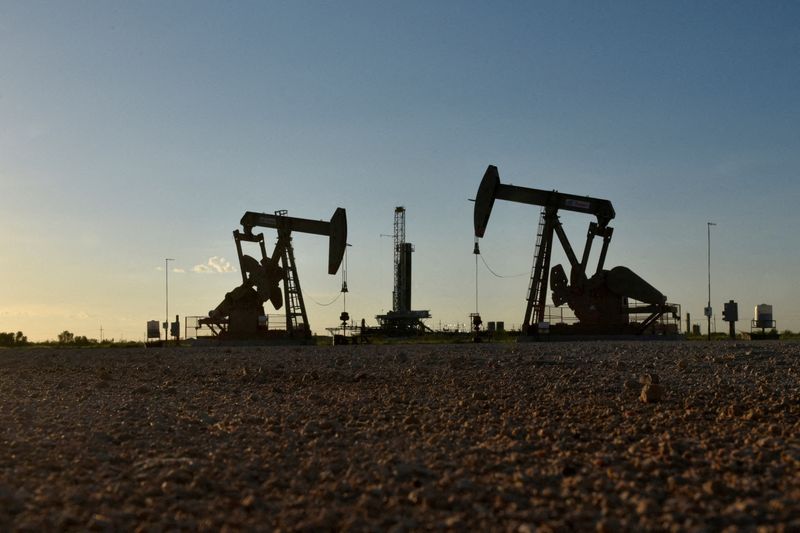Commodities
Oil dives 4% to lowest since July on demand worry, strong dollar


© Reuters. FILE PHOTO: Pump jacks operate in front of a drilling rig in an oil field in Midland, Texas U.S. August 22, 2018. REUTERS/Nick Oxford/File Photo
By Shariq Khan
BENGALURU (Reuters) -Oil prices fell more than 4% on Tuesday to their lowest since late July, as mixed Chinese economic data and rising OPEC exports eased fears about tight markets and as the dollar strengthened.
futures closed below $84 a barrel for the first time since Hamas Islamists’ Oct. 7 attack on Israel. The global benchmark settled at $81.61 a barrel, down $3.57, or 4.2%, while U.S. West Texas Intermediate crude futures settled at $77.37 a barrel, down $3.45, or 4.3%.
“Traders will remain on high alert for signs of a wider conflict emerging in the region that could disrupt supplies, but it seems those fears are subsiding,” OANDA analyst Craig Erlam said.
A recovery in oil exports from the Organization of Petroleum Exporting Countries also added to the pressure on oil prices, UBS analyst Giovanni Staunovo said.
“OPEC crude exports are up by about 1 million barrels per day (bpd) since their August low, as a result of seasonally lower domestic demand in the Middle East. It seems it is too much supply to be absorbed by oil consuming nations,” Staunovo said.
The premium on front-month loading Brent contracts over ones loading in six months was at a 2-1/2-month low, indicating less concern about supply deficits.
On the demand side, China’s crude oil imports in October showed robust growth but its total exports of goods and services contracted at a quicker pace than expected.
“The data signals the continued decline in the Chinese economic outlook driven by deteriorating demand in the country’s largest export destination: the West,” City Index analyst Fiona Cincotta said.
oil stocks rose by almost 12 million barrels last week, market sources said citing American Petroleum Institute figures. Oil prices extended losses slightly in post-settlement trading, with Brent futures down to $81.51 by 5:02 p.m. ET. [API/S]
The U.S. Energy Information Administration now expects total petroleum consumption in the country to fall by 300,000 bpd this year, reversing its earlier forecast of a 100,000 bpd increase.
Fading investor hopes for a peak in global interest rates also helped lift the U.S. dollar from recent lows, making oil more expensive for holders of other currencies. [MKTS/GLOB]
The U.S. central bank may have to do more to reduce inflation to its 2% target, Minneapolis Federal Reserve President Neel Kashkari said. Investors are awaiting comments from Fed Chair Jerome Powell, due on Wednesday and Thursday.
“There are concerns in the oil markets about both rising supply and sliding demand,” said Mizuho analyst Robert Yawger. “It’s certainly not a tight market right now,” he added.
Commodities
Oil prices rise; U.S. crude inventories plunge, Russia-Ukraine truce eyed
Commodities
India’s Reliance to stop buying Venezuelan oil over US tariffs, sources say
Commodities
Oil prices climb on Venezuela supply worries

 Forex3 years ago
Forex3 years agoForex Today: the dollar is gaining strength amid gloomy sentiment at the start of the Fed’s week

 Forex3 years ago
Forex3 years agoUnbiased review of Pocket Option broker

 Forex3 years ago
Forex3 years agoDollar to pound sterling exchange rate today: Pound plummeted to its lowest since 1985

 Forex3 years ago
Forex3 years agoHow is the Australian dollar doing today?

 Cryptocurrency3 years ago
Cryptocurrency3 years agoWhat happened in the crypto market – current events today

 World3 years ago
World3 years agoWhy are modern video games an art form?

 Commodities3 years ago
Commodities3 years agoCopper continues to fall in price on expectations of lower demand in China

 Economy3 years ago
Economy3 years agoCrude oil tankers double in price due to EU anti-Russian sanctions





























